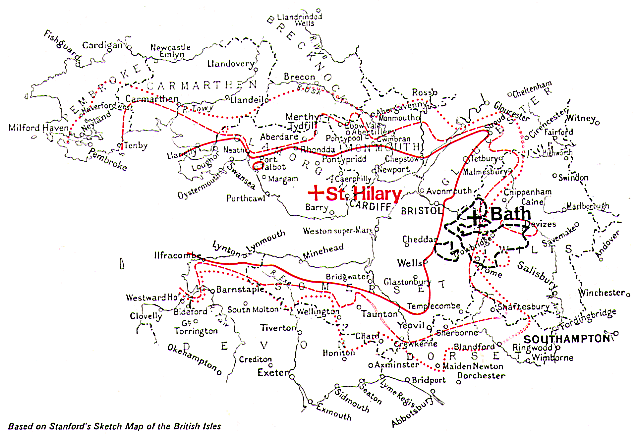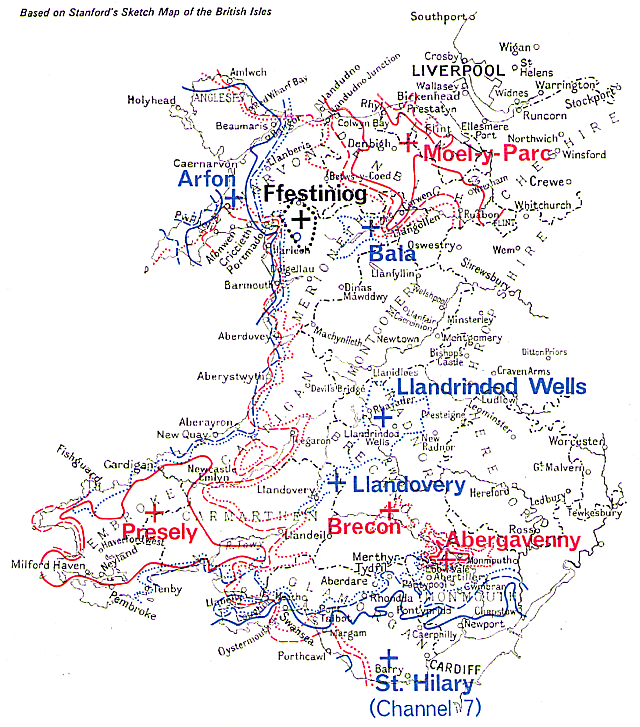 |
UK Broadcast Transmission |
|
|||||||||||
ITV 405 line VHF TV TRANSMITTERS
WALES and WEST of ENGLAND
| ST HILARY (West) | Bath | ST HILARY (Wales) | ARFON | |
| Channel / Polarisation | 10 V | 8 H | 7V | 10 H |
| Max. Vision ERP | 200 kW | 0.5 kW | 100 kW | 10 kW |
| Site ASL | 413 ft | 550 ft | 413 ft | 950 ft |
| Aerial ASL | 1113 ft | 678 ft | 1043 ft | 1904 ft |
| Location (NGR) | ST 026174 | ST 223015 | ST 026741 | SH 476493 |
| Bala | Llandovery | Abergavenny | MOEL-Y-PARC | |
| Channel / Polarisation | 7 V | 11 H | 11 H | 11 V |
| Max. Vision ERP | 0.1 kW | 0.1 kW | 0.1 kW | 25 kW |
| Site ASL | 1016 ft | 1023 ft | 1432 ft | 1063 ft |
| Aerial ASL | 1151 ft | 1154 ft | 1567 ft | 1812 ft |
| Location (NGR) | SH 969375 | SN 831405 | SO 244126 | SJ 123701 |
| PRESELY | Ffestiniog | Llandrindod Wells | Brecon | |
| Channel / Polarisation | 8 H | 13 V | 9 H | 8 H |
| Max. Vision ERP | 100 kW | 0.1 kW | 2.5 kW | 0.1 kW |
| Site ASL | 1063 ft | 1010 ft | 1420 ft | 737 ft |
| Aerial ASL | 1812 ft | 1145 ft | 1605 ft | 872 ft |
| Location (NGR) | SN 173306 | SH 709392 | SO 019635 | SO 054287 |

Two distinct Independent Television services were provided in Wales and the West of England.
South Wales and the West The Authority's St Hilary (Channel 10) station was sited at St Hilary Down, on the Welsh side of the Severn Estuary between Cardiff and Swansea and 413 ft above sea level. It serves the area surrounding the estuary and the Bristol Channel, including the densely-populated areas of South Wales and Monmouthshire, Somerset, and parts of Gloucestershire and other counties. The Authority would have preferred a mast height of 1,000 ft. but because of nearby Rhoose Airport the height had to be restricted to 750 ft. The e.r.p. is 200 kW omnidirectional. Since its opening for programme service on 14th January 1958 St Hilary (Channel 10) gave the high grade of service predicted, but the fundamental limitations of Band III transmission and reception in mountainous terrain when compared with Band I led to some public disappointment about the comparative grades of service in some shielded locations in the deep valleys of South Wales and also in low-lying parts of the cities of Bristol and Bath. The use of well-designed receiving aerials and of more sensitive 'fringe' area receivers has in part overcome the low signal strength and the 'ghost' images experienced in such localities. The Bath relay station came into service on I3th May 1968. Wales The Presely station was at Foel Drych in Pembrokeshire, 1,100 ft above sea level. The aerial radiated a narrow beam of 80 kW to the north to provide a reliable programme link to the Arfon relay station; a beam of 100 kW to the south-east linked the coverage contours with those of the St Hilary service area; and a broad lobe of 50 kW to the south-west served Pembrokeshire. Several severe power restrictions had to be met to avoid co-channel interference. The unattended Arfon station, which rebroadcast he Presely transmissions, was at Nebo, eight miles north-east of Pwllheli. A 1,000 ft mast is used to 'see' over the mountains of Portmadoc to the coast of Cardigan Bay from Harlech to Barmouth and to ensure a link-up with the service area of Presely. A directional aerial was again necessary. 10 kW is radiated to the north and south-west, 5 kW east and south-east, and 2 5 kW to the west. At the Moel-y-Parc station a 750 ft mast was needed to reach the coastal resorts from Conway to Prestatyn, shielded by mountains close to the coast. The radiation pattern was approximately semi-circular, 25 kW being radiated from south-east to northwest with reduced power north and east so as to cover the Welsh areas but avoid overlap with English areas already served. Moel-y-Parc rebroadcasts transmissions from Arfon, conveyed to it by an 'off the air' pick-up at Nebo, in Anglesey, and an ITA microwave link. At St Hilary it was desirable that the Welsh service on Channel 7 should be broadcast from the existing mast to reproduce as far as possible the Channel 10 coverage of Wales. Because of the power limitations to prevent co-channel interference, and the need to mount the Channel 7 transmitting aerial below that of the Channel 10 aerial (no increase in mast height was permissible because of aeronautical factors), the actual grade of service on Channel 7 was not in some areas as good as that on Channel 10. The Presely, Arfon and Moel-y-Parc stations were all in programme service by early 1963, St Hilary (Channel 7) in February 1965, Bala in July 1967 and Llandovery in August 1968. |

|